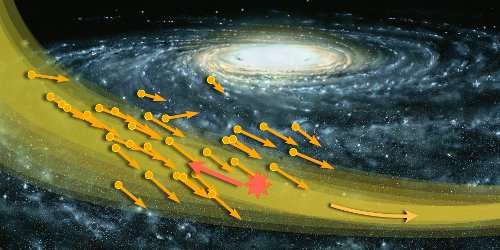November 13, 2018 report
Dark matter 'hurricane' offers chance to detect axions

A team of researchers from Universidad de Zaragoza, King's College London and the Institute of Astronomy in the U.K. has found that a "dark matter hurricane" passing through our solar system offers a better than usual chance of detecting axions. In their paper published in the journal Physical Review D, the group describes their findings and why they believe their observations could offer help in understanding dark matter.
The evidence for the existence of dark matter is very strong, yet scientists are still unable to find a way to actually "see" it. Because of that, they keep trying to find new ways to do so. In this new effort, the researchers have been studying the S1 stream—a collection of stars moving in a way that suggests they were once part of a dwarf galaxy that was consumed by the Milky Way. The S1 stream was discovered last year by a team studying data from the Gaia satellite. Other such streams have been observed before, but this is the first to cross paths with our own solar system. In this new effort, the researchers have studied the possible impact of S1 as it passed through our region, because it offers a unique opportunity to study dark matter.
As S1 moved through our area, theory suggests dark matter should have been moving along with it. Calculations by the team suggest it should be moving at approximately 500 km/s. They created several models showing the distribution of the dark matter and its density. Doing so allowed them to create predictions of possible signatures of the stream for researchers to look for. They suggest this event gives those in the field looking for observable evidence of dark matter a better than normal chance to do so. They suggest that it is not likely that WIMP detectors will find anything unusual. But they further suggest that the presence of a dark matter hurricane could increase the chances of detection of axionic dark matter due to possible bumps in the broad spectrum of axions. They note also that the current storm could offer data for use by future detection systems that are more advanced than those in use today.
More information: Ciaran A. J. O'Hare et al. Dark matter hurricane: Measuring the S1 stream with dark matter detectors, Physical Review D (2018). DOI: 10.1103/PhysRevD.98.103006 , On Arxiv: arxiv.org/abs/1807.09004
Journal information: Physical Review D , arXiv
© 2018 Science X Network





















